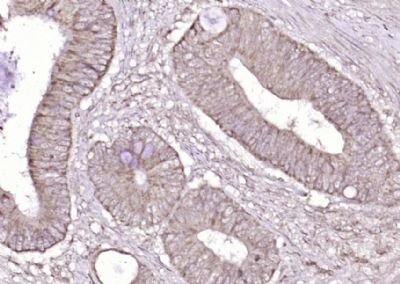产品货号 : mlR22150
英文名称 : CK14+17+42+10
中文名称 : 细胞角蛋白14抗体
别 名 : Cytokeratin 14; CK 14; ck14; Cytokeratin14; Cytokeratin-14; Dowling Meara; ebs3; Epidermolysis bullosa simplex; k14; Keratin 14; Keratin type I cytoskeletal 14; Keratin14; Koebner; Krt 14; krt14; EBS3; EBS4; NFJ; Keratin, type I cytoskeletal 14; Cytokeratin 17; CK 17; ck17; Cytokeratin17; Cytokeratin-17; Keratin, type I cytoskeletal 17; Cytokeratin 10; CK 10; ck10; Cytokeratin10; Cytokeratin-10; Keratin, type I cytoskeletal 10; Cytokeratin 42; CK 42; ck42; Cytokeratin42; Cytokeratin-42; Keratin, type I cytoskeletal 42; K1C14_HUMAN.
研究领域 : 肿瘤 细胞生物 免疫学
抗体来源 : Rabbit
克隆类型 : Polyclonal
交叉反应 : Human, Mouse, Rat,
产品应用 : IHC-P=1:400-800 (石蜡切片需做抗原修复)
not yet tested in other applications.
optimal dilutions/concentrations should be determined by the end user.
分 子 量 : 52kDa
细胞定位 : 细胞核 细胞浆
性 状 : Lyophilized or Liquid
浓 度 : 1mg/ml
免 疫 原 : KLH conjugated synthetic peptide derived from human CK14+17+42+10:411-472/472
亚 型 : IgG
纯化方法 : affinity purified by Protein A
储 存 液 : 0.01M TBS(pH7.4) with 1% BSA, 0.03% Proclin300 and 50% Glycerol.
保存条件 : Store at -20 °C for one year. Avoid repeated freeze/thaw cycles. The lyophilized antibody is stable at room temperature for at least one month and for greater than a year when kept at -20°C. When reconstituted in sterile pH 7.4 0.01M PBS or diluent of antibody the antibody is stable for at least two weeks at 2-4 °C.
PubMedPubMed
产品介绍 This gene encodes a member of the keratin family, the most diverse group of intermediate filaments. This gene product, a type I keratin, is usually found as a heterotetramer with two keratin 5 molecules, a type II keratin. Together they form the cytoskeleton of epithelial cells. Mutations in the genes for these keratins are associated with epidermolysis bullosa simplex. At least one pseudogene has been identified at 17p12-p11. [provided by RefSeq].
Function:
The nonhelical tail domain is involved in promoting KRT5-KRT14 filaments to self-organize into large bundles and enhances the mechanical properties involved in resilience of keratin intermediate filaments in vitro.
Subunit:
Heterotetramer of two type I and two type II keratins. keratin-14 associates with keratin-5. Interacts with TRADD and with keratin filaments. Associates with other type I keratins.
Subcellular Location:
Cytoplasm. Nucleus. Note=Expressed in both as a filamentous pattern.
Tissue Specificity:
Detected in the basal layer, lowered within the more apically located layers specifically in the stratum spinosum, stratum granulosum but is not detected in stratum corneum. Strongly expressed in the outer root sheath of anagen follicles but not in the germinative matrix, inner root sheath or hair. Found in keratinocytes surrounding the club hair during telogen.
Post-translational modifications:
A disulfide bond is formed between rather than within filaments and promotes the formation of a keratin filament cage around the nucleus.
DISEASE:
Epidermolysis bullosa simplex, Dowling-Meara type (DM-EBS) [MIM:131760]: A severe form of intraepidermal epidermolysis bullosa characterized by generalized herpetiform blistering, milia formation, dystrophic nails, and mucous membrane involvement. Note=The disease is caused by mutations affecting the gene represented in this entry.
Epidermolysis bullosa simplex, Weber-Cockayne type (WC-EBS) [MIM:131800]: A form of intraepidermal epidermolysis bullosa characterized by blistering limited to palmar and plantar areas of the skin. Note=The disease is caused by mutations affecting the gene represented in this entry.
Epidermolysis bullosa simplex, Koebner type (K-EBS) [MIM:131900]: A form of intraepidermal epidermolysis bullosa characterized by generalized skin blistering. The phenotype is not fundamentally distinct from the Dowling-Meara type, although it is less severe. Note=The disease is caused by mutations affecting the gene represented in this entry.
Epidermolysis bullosa simplex, autosomal recessive (AREBS) [MIM:601001]: An intraepidermal epidermolysis bullosa characterized by localized blistering on the dorsal, lateral and plantar surfaces of the feet. Note=The disease is caused by mutations affecting the gene represented in this entry.
Naegeli-Franceschetti-Jadassohn syndrome (NFJS) [MIM:161000]: A rare autosomal dominant form of ectodermal dysplasia. The cardinal features are absence of dermatoglyphics (fingerprints), reticular cutaneous hyperpigmentation (starting at about the age of 2 years without a preceding inflammatory stage), palmoplantar keratoderma, hypohidrosis with diminished sweat gland function and discomfort provoked by heat, nail dystrophy, and tooth enamel defects. Note=The disease is caused by mutations affecting the gene represented in this entry.
Dermatopathia pigmentosa reticularis (DPR) [MIM:125595]: A rare ectodermal dysplasia characterized by lifelong persistent reticulate hyperpigmentation, non-cicatricial alopecia, and nail dystrophy. Variable features include adermatoglyphia, hypohidrosis or hyperhidrosis, and palmoplantar hyperkeratosis. Note=The disease is caused by mutations affecting the gene represented in this entry.
Similarity:
Belongs to the intermediate filament family.
SWISS:
P02533
Gene ID:
3861
Important Note:
This product as supplied is intended for research use only, not for use in human, therapeutic or diagnostic applications.
CK14属于酸性角蛋白。在乳腺腺体和导管肌上皮细胞、唾液腺腺泡和导管的肌上皮细胞以及鳞状上皮的基底细胞中阳性表达。大多数鳞状细胞癌表达阳性,并且阳性表达的频率与其分化程度无明显关系。主要用于鳞状细胞癌的判断,尤其用于低分化鳞癌判断中。
产品图片












